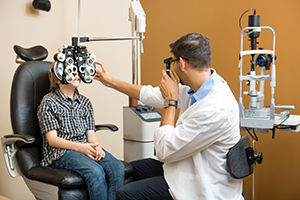Parents Should Get Schooled on Back-to-School Eye Care

Allan M. Eisenbaum, M.D., a pediatric ophthalmologist at Texas Tech Physicians of Lubbock Eye Clinic and an associate professor of the Texas Tech University Health Sciences Center Department of Ophthalmology, said to check out these symptoms of eye problems that should raise your suspicions.
Discharge
This often signifies an infection. Pus-like discharge is more common with a bacterial
infection, while a watery or ropey discharge occurs more commonly with allergy. A
clear discharge may occur with viral infections.
Pinkeye
A generic term that describes the white of the eye being red because of inflammation
of the conjunctival tissue overlying the white of the eye and back of the eyelids.
Like fever, this is a nonspecific term that does not address the cause of inflammation.
There are multiple causes, including infection. In school-age children, it is not
uncommon for a virus to be the cause. This is the pinkeye that is quite contagious
when caused by adenovirus. While contagious, children with adenovirus should be removed
from school. Contact with them should be minimal, particularly by anyone who has a
compromised immune system. In preschool children infection-causing pinkeye is usually
bacterial and responds well to the appropriate antibiotic. Viral infection does not
respond to antibiotics. Bacterial conjunctivitis is usually limited to several days,
while adenovirus can last two weeks or more.
Eye Misalignment
Eye misalignment or lazy eye can be obvious or quite subtle. There may be limitation
in how far one or both eyes move. The child may adopt a head position to compensate
for the misalignment. Squinting may also be present. Expect a child to have well-aligned
eyes that move together over the full range of motion after two to three months of
age.
Squinting
Children with eye misalignments may squint to avoid double vision. Other children
squint because light causes pain in an inflamed eye. The most common cause for squinting
is an uncorrected nearsightedness, requiring glasses. Expect both eyes to be equally
wide open.
Tearing
Blocked tear ducts are the most common cause of excessive tearing in children but
other causes are light sensitivity, allergy, a scratched eye or foreign body.
Eye Rubbing
This can be a symptom of allergy or habit. Chronic eye rubbing can be a concern because
it can damage the cornea, the clear part of the eye. Some children who are blind or
nearly blind rub their eyes to stimulate flashes of light.
Droopy Eyelid
Medically known as ptosis, this usually occurs on a congenital basis. It may be mild
to quite severe. Causes include a weak muscle in the eyelid or sometimes a tumor in
the affected eyelid. A droopy eyelid can be associated with poor vision and therefore
needs evaluation. Possible treatments include glasses for nearsightedness and astigmatism,
patching of the sound eye and surgical correction.
Blind or Nearly Blind
Besides rubbing their eyes, affected children may have a tendency to stare into bright
light and wave their hands in front of their faces to contrast light and shadows.
Another concern is the child who cannot navigate in a darkened room. This could be
a form of night blindness.
Jiggling or Dancing Eyes
This occurs in a small percentage of children. These unstable eye movements are known
as nystagmus. Nystagmus may interfere with vision or be associated with poor vision.
Nystagmus needs to be evaluated promptly because it not only affects vision but also
could be associated with systemic disease.
Abnormal Appearance of the Pupil
Instead of a normal black pupil in the center of each eye, the pupil turns white.
Leukocoria is the term for a white pupil. This is a serious condition because it is
caused often by problems that can seriously affect vision, like a cataract, or even
cancer inside the eye of an infant. Abnormalities of the shape of the pupil also can
occur and need to be evaluated.
“Be aware of your children’s vision and be vigilant for eye problems in our young ones,” Eisenbaum said. “Prompt evaluation of suspected eye problems and appropriate treatment when indicated will help maintain the sparkle in your child’s eyes this new school year.”
Related Stories
Celebrating Veterans: TTUHSC’s General Martin Clay’s Legacy of Service and Leadership
From his initial enlistment in the Army National Guard 36 years ago to his leadership in military and civilian health care management roles, Major General Martin Clay’s career has been shaped by adaptability, mission focus and service to others.
Texas Tech University Health Sciences Center School of Nursing Named Best Accelerated Bachelor of Science in Nursing Program in Texas
The TTUHSC School of Nursing Accelerated Bachelor of Science in Nursing (BSN) program has been ranked the No. 1 accelerated nursing program in Texas by RegisteredNursing.org.
TTUHSC Names New Regional Dean for the School of Nursing
Louise Rice, DNP, RN, has been named regional dean of the TTUHSC School of Nursing on the Amarillo campus.
Recent Stories
Abid Brings Hematology Expertise to TTUHSC Oncology Team
Muhammad Bilal Abid, M.D., has joined the TTUHSC School of Medicine oncology team as an associate professor of internal medicine and medical director of TTUHSC’s Blood and Marrow Transplantation & Cellular Therapy Program.
Research Team Studies Cardiovascular Disease Risk in Homeless Population
A team of student researchers from TTUHSC and TTU evaluated differences in CVD risk between men and women experiencing poverty and homelessness in West Texas, a medically underserved region within the TTUHSC service area.
Clinical Trials Provide Access to Latest Cancer Interventions
Beginning in 2008, TTUHSC, through the School of Medicine Pediatric Cancer Research Center in 2025, has conducted multiple phase 1 oncology clinical trials for pediatric and adult cancer patients. These trials will pave new ground for patients now and in the future.
